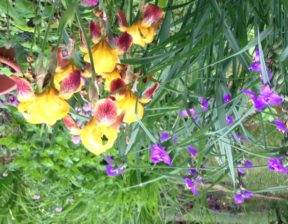Yard & Garden Notes: South Common Historic District
This is the fifth in a series of reports about wild and cultivated things on my property in the South Common Historic District, close to the Lowell Connector and Thorndike-Dutton gateway into the city. These updates are offered in the spirit of The Flowering City, a concept about 20 years old that emerged from a community visioning process led by the Human Service Corporation in pursuit of the “botanical garden” theme for Lowell articulated by the late Patrick J. Mogan.—-PM
I’ve made an effort to learn the names of the growing things in my yard and garden. The photo below shows yellow irises and a bunch of spiderwort, specifically, I think, Virginia Spiderwort, a prolific and floppy perennial that grows from Canada to Argentina and produces small purple flowers that open in the morning and close at sunset. I don’t remember planting this one, which occurs in my main garden and a narrow side garden, so it may be a volunteer going back years. It’s been there as long as I can remember, dense with deep green leaves and thick stems that ooze when cut. The roots and leaves are edible, according to sources on the web, and the plant has medicinal value also as a poultice, sedative, and more.
The iris—well, there are more than 250 species, so I can’t provide a lot of detail there. I got these yellow ones from a friend, and they have taken to their new home nicely. Unlike some other iris plants in the garden that produce only the blade-like leaves, this yellow variety has yielded a whole bouquet of blossoms. The name, iris, is from the Greek word for rainbow. The authorities on the web say the name may derive from the fact that the flower comes in so many different colors. The iris, of course, is also the colored part of our eyes.
